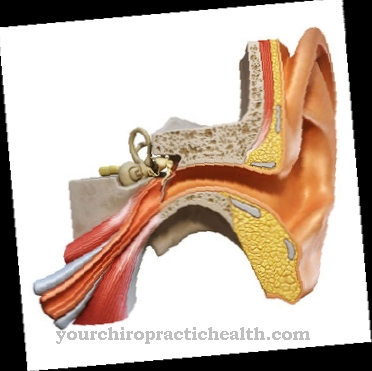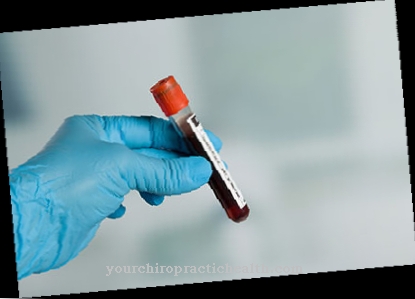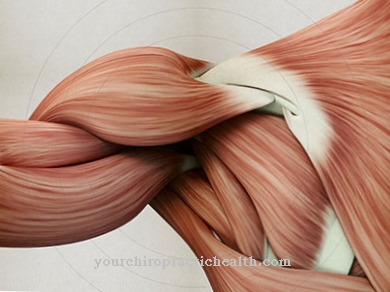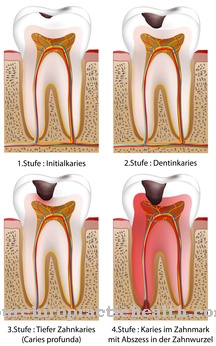As Hypoalbuminemia is called a form of hypoproteinemia. This leads to a too low albumin content in the blood. Albumin is a plasma protein that is responsible as a means of transport for many small molecules. A deficiency in this protein can therefore cause various disorders such as the formation of edema and low blood pressure.
What is hypoalbuminemia?

© Vasyl - stock.adobe.com
In medicine it is Hypoalbuminemia also as Hypoalbuminemia known. It is the most common form of hypoproteinemia, in which the blood plasma has a reduced content of proteins. In the case of hypoalbuminemia, the blood albumin content is too low.
Albumin is an important protein in the human organism. It produces over 50 percent of all proteins found in blood vessels. The albumin is created in the liver and is produced by the liver cells (hepatocytes). The normal total amount of albumin in the body is over 300 grams.
Albumin is important as a carrier for numerous other substances, including trace elements, hormones, bilirubin and fatty acids. In addition, the protein ensures the maintenance of 75 to 80 percent of the colloid osmotic pressure.
If there is a pathological deficiency of albumin in the blood, this leads to the development of edema (water retention) in the body due to a reduced colloid osmotic pressure. Albumin is also important for the binding of various drugs. In hypoalbuminemia, these drugs are free in the blood plasma, which in turn results in higher drug levels.
causes
Normally, the human body keeps the albumin level in the blood constant. If there is a lower synthesis compared to the loss, this leads to a lowering of the protein. Possible causes of hypoalbuminemia are reduced albumin production due to permanent liver damage, kidney damage or malnutrition.
Loss of albumin can also result from burns with large wound areas or acute inflammations. Other possible reasons are protein-losing enteropathy or exudative pancreatitis (inflammation of the pancreas). A disruption of protein synthesis can also be seen in an antibody deficiency syndrome or liver cirrhosis.
Furthermore, food intolerances such as celiac disease, anorexia nervosa (anorexia) and gastrointestinal tumors can be responsible for the loss of albumin. Physiological hypoalbuminemia occurs during pregnancy, which usually occurs in the 3rd trimester.
It is the result of proteinuria and causes edema to develop in pregnant women. The reasons for this are both an increased plasma volume and an increasing glomerular patency. This increases the excretion of albumin via the kidneys.
If the albumin loss through the urine is more than 300 milligrams per day, this is no longer considered harmless and can be an indication of the onset of preeclampsia. A loss of more than three grams of protein per day is considered a serious loss.
Symptoms, ailments & signs
The lack of albumin in the body causes the colloid osmotic pressure within the blood plasma to drop. As a result, the water cannot be kept in physiological quantities in the vascular system. There is therefore a passage into the interstitium (cell space). This in turn leads to the formation of edema.
Albumin is the protein that can be found most frequently in the human organism. It also ensures the transport of drugs and hormones. The lack of the protein therefore affects their effectiveness. Other symptoms of a protein deficiency are low blood pressure, pleural effusion and ascites (water belly).
This causes a larger amount of fluid to accumulate between the organs in the abdomen. With a pleural effusion, on the other hand, water accumulates in the lungs. In the case of a water belly there is the risk that intestinal bacteria penetrate the abdomen, which in turn can result in a threatening infection.
It is not uncommon for the lack of albumin to lead to an increased concentration of fatty acids, hormones and bilirubin in the blood. The absorption capacity of the albumins is too low due to the hypoalbuminemia.
Diagnosis & course of disease
A doctor should be consulted if hypoalbuminemia or hypoproteinemia is suspected. Based on the symptoms, he can initially only make a suspected diagnosis. The low albumin concentration can be determined by means of serum protein electrophoresis, in which a reduced albumin peak can be determined.
A measurement of the serum albumin is also possible. The deficiency in albumin can be distinguished from a concentration of immunoglobulins that is too low. Because hypoalbuminemia does not show up alone, the underlying disease that causes it must also be diagnosed. Recognizing the causes for the following therapy is of the utmost importance.
In order for hypoalbuminemia to take a positive course, it is important to treat the underlying disease responsible. Long-term therapy may be required in the case of chronic diseases. If the triggering cause is successfully combated, this usually leads to the normalization of the albumin concentration.
Complications
In most cases, the hypoalbuminemia results in a relatively low blood pressure in the patient. Furthermore, various other complaints and symptoms can occur due to the lack of protein and make everyday life difficult for the person concerned. The reduced blood pressure also reduces the patient's resilience, so that sporting activities or physical exertion can usually no longer be carried out.
It is not uncommon for people to faint, which can also injure themselves. The patient appears tired and exhausted and often no longer takes an active part in life. Furthermore, there is a so-called water belly, which can lead to various infections and inflammations. The affected person's immune system is also weakened, so that they are more likely to develop infections and inflammations.
The treatment usually does not result in any particular complications. This always takes place causally and depends on the underlying disease that is responsible for the hypoalbuminemia. It is not uncommon for hypoalbuminemia to be caused by malnutrition, so treatment should definitely be accompanied by a psychologist.
When should you go to the doctor?
If symptoms such as low blood pressure or signs of a water belly are noticed, the problem may be hypoalbuminemia. A doctor should be consulted if symptoms persist for a long time or if they cause severe discomfort over time. If you feel dizzy, tired or in severe pain, you must always go to your family doctor. Effusions and infections that appear to occur for no reason also require rapid clarification.
Patients who are malnourished due to an eating disorder are particularly susceptible to hypoalbuminemia. Even after major burns or acute inflammations, there is an increased risk of too low an albumin content in the blood. Anyone who belongs to these risk groups should see a doctor immediately with the symptoms mentioned. Older people and pregnant women should also have unusual complaints clarified quickly in order to avoid complications. Children are best taken to the pediatrician. In severe cases, such as increasing pain or acute inflammation, a visit to the hospital is always indicated.
Doctors & therapists in your area
Treatment & Therapy
The treatment of hypoalbuminemia goes hand in hand with the therapy of the underlying disease which is the cause of the albumin deficiency. If there is an escape of water from the blood vessels, this is stopped. In this way, the edema regresses.
In the case of a pronounced water belly, a puncture can take place through the abdominal wall, with which the excess water can be drained off. Diuretics are also prescribed to remove water retention. In the case of malnutrition due to anorexia, psychotherapy is often useful. The diet must also be adjusted accordingly.
You can find your medication here
➔ Medicines to strengthen the defense and immune systemOutlook & forecast
The prognosis of hypoalbuminemia depends on the causal disease. If medical care is not provided, the prognosis for these patients can be described as poor. If the disease progresses difficult, there is organ damage and a donor organ is required. Alternatively, the person concerned threatens to die prematurely.
If the underlying disease can be treated well, the prognosis is favorable.In the case of malnutrition, the missing nutrients or trace elements are compensated for, so that after a few weeks or months there is no symptom. However, a relapse is possible at any time as soon as the defect reappears.
If there are severe burns, the prospect of a cure worsens. A skin graft is often needed. Long-term therapy is also necessary to alleviate the symptoms. Chronic illnesses usually have a protracted disease course. Cure is possible in many patients, but sometimes it can take years for improvement to occur.
In addition to the physical irregularities, psychological stability must be taken into account in order to promote recovery. If there is an intolerance, if all requirements are taken into account, the hypoalbuminemia can be free of symptoms. If the patient pays close attention to the ingredients in the intake of food or medication, the development of anemia can be adequately prevented.
prevention
Because of the numerous underlying diseases that can cause hypoalbuminemia, no meaningful preventive measures are known. If the underlying disease can be determined, its treatment is considered the best prevention.
Aftercare
In the case of hypoalbuminemia, there are usually no special options and measures available for follow-up care. The person concerned is primarily dependent on early detection and treatment of this disease so that the symptoms do not worsen or further complications do not occur. As a rule, in hypoalbuminemia, the underlying disease must first be identified and then treated.
Only through proper treatment of the underlying disease can symptoms be completely relieved. The treatment takes place by draining the water, whereby most of those affected also have to take medication. It is important to ensure that the medication is taken correctly and regularly. In the case of children, parents must pay attention to the intake and consult a doctor if they have any questions or if anything is unclear.
Since hypoalbuminemia can also lead to depression or psychological distress, psychological therapy should be started early. The loving care and support from friends and family also have a very positive effect on the further course of the disease. In many cases, it is also important to eat the right diet in order to counteract this deficiency.
You can do that yourself
When treating hypoalbuminemia, the doctor focuses on treating the underlying disease. This is usually done using antibiotics and diuretics. However, the patient can take some measures themselves to promote recovery and reduce the risk of complications.
If the symptoms are due to malnutrition, the diet must be changed. The patient should contact a specialist or nutritionist for this. Together with the specialist, an individual nutrition plan can be created that is based on the physical complaints and optimally supports the healing process. In addition, psychotherapy is often necessary, as persistent malnutrition is often caused by serious emotional complaints. Patients suffering from anorexia should immediately go to a counseling center and make an appointment for further therapy.
In addition, the symptoms must be treated. Cooling and rest help against pressure pain caused by edema. Gentle ointments such as marigold ointment or arnica also help against such ailments. If these measures have no effect, a doctor must be consulted. The same applies to unusual symptoms and acute pain.






.jpg)




















